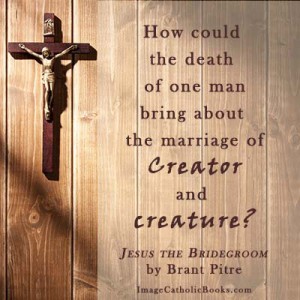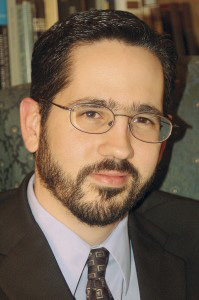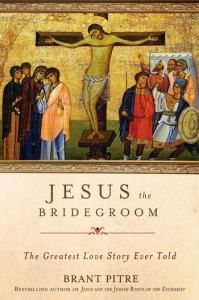Dr. Pitre’s “Jesus The Bridegroom” — An Interview and Excerpt
by Sarah Reinhard | March 17, 2014 12:01 am
 [1]The premise behind scripture professor and popular speaker Dr. Brant Pitre’s new book is one that turned my head. It delves into something that’s confusing when you stop to think about it.
[1]The premise behind scripture professor and popular speaker Dr. Brant Pitre’s new book is one that turned my head. It delves into something that’s confusing when you stop to think about it.
Jesus, a bridegroom. OK, yeah, but isn’t that a metaphor?
Turns out, not so much.
From the Publisher:
“In ‘Jesus the Bridegroom’, Brant Pitre once again taps into the wells of Jewish Scripture and tradition, and unlocks the secrets of what is arguably the most well-known symbol of the Christian faith: the cross of Christ. In this thrilling exploration, Pitre shows how the suffering and death of Jesus was far more than a tragic Roman execution. Instead, the Passion of Christ was the fulfillment of ancient Jewish prophecies of a wedding, when the God of the universe would wed himself to humankind in an everlasting nuptial covenant.”
This book follows on the heels of his popular Jesus and the Jewish Roots of the Eucharist (2011, Image Books), which flew off the shelves in a way that usually only books by certain other bearded Catholic theologians do.
Pitre’s a Louisiana resident with a wife, five kids, and probably a house full of cool parade gear junk, if I have my geography correct. (The parade season in New Orleans has inspired me, what can I say?) He teaches scripture at the seminary by day, and lectures packed auditoriums by night. I suspect he keeps a cape in his briefcase and has superpowers such as not needing as much sleep as the rest of us and remembering everything he’s ever read.
Needless to say, I couldn’t resist the chance to send a few questions his way… And be sure to stay tuned all the way to the end, because Image Books was kind enough to let us share an excerpt from the book!
Q: Brant, looking at your bio, I can’t help but wonder if you sleep. 🙂 What’s your secret for juggling so much? How do you manage to live a life that’s integrated and Catholic and not lose your mind?
Self-discipline, prudence, temperance, and fortitude… By which I mean that my wife Elizabeth basically keeps me from falling apart on a regular basis! (My five kids can testify that I’ve already lost my mind, so I’m no longer worried about that one.)
But seriously—daily prayer, the Eucharist, and my family are the most important things in my life, and they sustain me in trying to be a faithful disciple. I also have the great privilege of getting up every day and going to work to teach about the Bible at a Seminary! My books and Bible studies on CD are simply a way of sharing what my students and I discover in the classroom together. (And a way of paying for groceries and student loans.)
Q: Your latest book has quite a compelling title. Tell us what inspired you to write Jesus the Bridegroom.
 [2]
[2]Dr. Brant Pitre
Several years ago, I gave a lecture on “The Bridegroom Messiah and the Eucharist.” In that talk, I traced the story of the Bible from the first wedding in Genesis to the final Wedding of the Lamb at the end of the book of Revelation. At the center stood the crucifixion of Jesus as his wedding day and the Last Supper as his wedding banquet.
The response to the lecture was phenomenal. It really seemed to touch something deep in the audience, by helping them see the passion of Jesus—and the whole history of the world—through the lens of a love that is concrete and made visible in the life of Christ.
I realized I was onto something, and began learning as much as I could about ancient Jewish wedding customs and the biblical prophecies of the Bridegroom God coming to marry his people. As I dove in, dozens of passages in the Bible—the Exodus, the Song of Songs, the Wedding at Cana, the Last Supper, the Crucifixion, the End of Time—suddenly sprang to life and were filled with new meaning for me as chapters in a divine love story between Creator and creature, between God and Israel, between Christ and the Church.
Q: What was your greatest challenge as you pulled this project together? What was your approach to overcoming that challenge?
The greatest challenge by far was deciding what to leave out! As I discovered in my research, Jesus the Bridegroom is not some ‘peripheral’ idea for mystics only. It is central to the Bible, and it was one of the favorite topics of the early Church Fathers when they catechized new converts to Christianity about the Good News of God’s love.
At first I thought might have too little material, but I ended up with too much. The way I overcame this challenge was by choosing what I thought were the most important moments in the life of the Bridegroom: the Song of Songs, the Wedding at Cana, the Woman at the Well, the Last Supper, the Crucifixion. The episodes my students found most moving were the ones that ended up in the book.
Q: One of the endorsements for this book is from Dr. Scott Hahn. He says, “This book will change you.” How do you hope readers are changed and expect them to be transformed by reading your book?
Wow! Let’s see. Above all, I hope that it will transform the way people see Jesus and his Passion. I hope it will help them see that he’s more than just a great Teacher, or Miracle Worker, or even the Jewish Messiah. Even more, Jesus is the Bridegroom God made flesh. That means he didn’t just come to save humanity from sin and hell. He came and died on the cross in order to unite us to himself forever in a personal relationship of love. So many people today think of salvation simply as ‘not going to hell’. But if Jesus is the Bridegroom Messiah, then salvation is not just about deliverance from sin; it’s about union with God. And the way he achieves this union is precisely through the Wedding Banquet of the Last Supper and the Wedding Day of his Passion. If, after reading the book, a person looks at Crucifix and sees the beauty of suffering transformed by love, then I’ll consider my work done.
Along these lines, perhaps my favorite chapter in the book is called “the Bridal Mysteries.” In that chapter, I look at how the Catholic faith has always seen Baptism, the Eucharist, Matrimony, and Consecrated Virginity as nuptial mysteries. That means that the mystery of Jesus the Bridegroom and the Church as his Bride is something that touches every single Christian life. In fact, the way Jesus shows us his love is precisely through the sacraments, above all, the Eucharist, which is the Wedding Feast of the Lamb.
Q: What does your family think of this project? Do your wife and kids read your books and comment on them?
My wife Elizabeth is quite literally my ‘in-house’ editor. She reads everything I write for popular consumption and gives me great feedback. (She’s a much better writer than me, so if you like the book, you can thank her.) In this case, she actually made me rewrite my entire first draft! My kids, by contrast, mostly play in the backyard. Though I may make my oldest daughter read Jesus the Bridegroom this Lent as a penance.
Excerpt…
 [3]
[3]
Jesus the Bridegroom (Introduction)
What do you see when you look at a crucifix? Different people see different things. Do you see the brutal execution of an ancient Jewish man at the hands of the Roman authorities? Or the unjust punishment of a great teacher, who was tragically misunderstood by the leaders of his day? Do you see the martyrdom of the Jewish Messiah, who was killed for claiming to be “the king of the Jews”? Or the sacrifice of the divine Son of God, who willingly took upon himself the sins of the world? In the first century A.D., the apostle Paul — a former disciple of the Jewish rabbi Gamaliel — saw all of these things. But he also saw something more in the crucifixion of Jesus of Nazareth. Paul saw the love of a bridegroom for his bride. In one of the most famous (and controversial) passages he ever penned, the apostle describes the passion and death of Jesus in terms of the love of a husband for his wife. Speaking to husbands and wives in the church at Ephesus, Paul writes these words:
Wives, submit to your husbands, as to the Lord. For the husband is the head of the wife as Christ is the head of the church his body, and is himself its Savior. As the church submits to Christ, so let wives also submit in everything to their husbands. Husbands, love your wives, as Christ loved the church and gave himself up for her, that he might sanctify her, having cleansed her by the washing of water with the word, that he might present the church to himself in splendor, without spot or wrinkle or any such thing, that she might be holy and without blemish. . . . “For this reason a man shall leave his father and mother and be joined to his wife, and the two shall become one.” This is a great mystery, and I mean in reference to Christ and the church. (Ephesians 5:21–27, 32)
Now, I realize that many readers may be thinking: “Wives do what?!” Why does Paul tell wives to “submit” to their husbands? And why do husbands apparently get off so easy, with the simple command to “love” their wives? Is Paul some kind of apostolic chauvinist? What in the world does he mean when he says such things?
I promise to get to that later on in the book. Before we can, however, we first need to focus our attention on what lies be- hind these controversial words: Paul’s description of Christ as a bridegroom, the Church as his bride, and the crucifixion of Jesus as the kind of ancient Jewish wedding day on which he “loved” her and “gave himself ” for her. Indeed, as we will see later on, when Paul refers to the Church being “washed” and “presented” to Christ, he is describing the ancient Jewish bridal bath and wedding ceremony. From Paul’s point of view, the torture and crucifixion of Jesus on Calvary was nothing less than an expression of spousal love.
What are we to make of this mysterious analogy? To be sure, most Christians are familiar with the idea that Christ is “the Bridegroom” and the Church is “the Bride.” But what does this really mean? And what would ever possess Paul to think of such a comparison? If you had been there at the foot of the bloody cross, with Jesus hanging there dying, is that how you would have described what was happening? How could a first- century Jew like Paul, who knew how horribly brutal Roman crucifixions were, have ever compared the execution of Jesus to the marriage between a bridegroom and his bride? Is this just an elegant metaphor? If so, why then does Paul refer to it as a “great mystery” (Greek mysterion mega) (Ephesians 5:32)?
As I hope to show in this book, it is precisely because Paul was Jewish that he saw the passion of Christ in this way. It is precisely because Paul knew Jewish Scripture and tradition that he was able to see the crucifixion of Jesus of Nazareth as more than just a Roman execution, an unjust martyrdom, or even the sacrifice of the Son of God. Because of his Jewish background, Paul saw the passion and death of Christ as the fulfillment of the God of Israel’s eternal plan to wed himself to humankind in an everlasting marital covenant. As we will see in this book, from an ancient Jewish perspective, in its deepest mystery, all of salvation history is in fact a divine love story between Creator and creature, between God and Israel, a story that comes to its climax on the bloody wood of a Roman cross.
In order for us to see all of this, however, we will have to go “back in time” to the first century A.D. and take off our modern “eyeglasses” and try to see both the love of God and the passion of Jesus the way the apostle Paul and other ancient Christians saw them — through ancient Jewish eyes. In other words, we will have to go back and reread the accounts of the life, death, and resurrection of Jesus in light of ancient Jewish Scripture and tradition.
When we do this, we will discover that Paul is not the only person who talked this way. In the early stages of Jesus’ ministry, John the Baptist — another first-century Jew — refers to Jesus as “the Bridegroom” (John 3:29), even though Jesus has no wife. Later on, in one of his most mysterious parables, Jesus refers to himself as “the bridegroom,” and calls his disciples “the sons of the bridechamber” (Mark 2:18–19). Moreover, the very first miracle Jesus performs takes place at a Jewish wedding, when he acts like a bridegroom by miraculously providing wine for the wedding party (John 2:1–11). Most striking of all, the last days of Jesus’ life — the Last Supper, the passion, and his crucifixion and death — when examined through the lens of ancient Jewish Scripture and tradition, look mysteriously similar to certain aspects of an ancient Jewish wedding. According to the book of Revelation (written by yet another Jewish Christian), the world itself ends with a wedding: the eternal “marriage supper of the Lamb” and the unveiling of the new Jerusalem as the Bride of Christ (Revelation 19, 21).
In other words, when seen through ancient Jewish eyes, Jesus of Nazareth was more than just a teacher, or a prophet, or even the Messiah; he was the bridegroom God of Israel come in the flesh. As the Bridegroom Messiah, his mission was not just to teach the truth, or proclaim the kingdom, but to forgive the sinful bride of God and unite himself to her in an everlasting covenant of love. In the words of the Catechism of the Catholic Church:
The Son of God, by becoming incarnate and giving his life, has united to himself in a certain way all mankind saved by him. . . . The entire Christian life bears the mark of the spousal love of Christ and the Church. (CCC 1612, 1617)
So, if you’ve ever found yourself puzzled by the words of the apostle Paul, or if you’ve ever wondered exactly what it means to say that Christ is “the Bridegroom” and the Church is his “bride,” or if you’ve just wanted to understand better who Jesus was and why he was crucified, then I invite you to come along on this journey of discovery.
As we will see, by looking at the love of God and the passion of Christ through the lens of the Bridegroom Messiah, we can transform not only the way we see Jesus and his death, but also how we understand baptism, the Lord’s Supper, marriage, virginity, and even the end of the world. While many a man through- out history has jokingly described his wedding day as his funeral, Jesus of Nazareth is the only man who ever solemnly described his funeral as his wedding day. This book explains why, and what it means for who he was, why he lived, and why he died on the cross.
Before we can begin to see Jesus differently, however, we first have to go back to the beginning of the love story, and try to see God differently, through ancient Jewish eyes.
~ ~ ~ ~ ~
Excerpted from Jesus the Bridegroom by Brant Pitre Copyright © 2014 by Brant Pitre. Excerpted by permission of Image, a division of Random House LLC. All rights reserved. No part of this excerpt may be reproduced or reprinted without permission in writing from the publisher.
Sarah Reinhard is a Catholic wife, mom and author whose nose is probably in a book if she’s not scraping something off of her shoes. Her latest book is A Catholic Mother’s Companion to Pregnancy: Walking with Mary from Conception to Baptism. Check out all of her books at http://sarahreinhard.com/writing/my-books/[4].
Visit Sarah’s website: http://sarahreinhard.com/[5]
If you liked this article, please share it with your friends and family using the Share and Recommend buttons below and via email. We value your comments and encourage you to leave your thoughts below. Thank you! – The Editors
- [Image]: http://www.integratedcatholiclife.org/wp-content/uploads/marriage-of-creator-creature-quote-pin-pitre.jpg
- [Image]: http://www.integratedcatholiclife.org/wp-content/uploads/pitre-brant-w199x300.jpg
- [Image]: http://www.integratedcatholiclife.org/wp-content/uploads/pitre-jesus-the-bridegroom-cover-w350.jpg
- http://sarahreinhard.com/writing/my-books/: http://sarahreinhard.com/writing/my-books/
- http://sarahreinhard.com/: http://sarahreinhard.com/
Source URL: https://integratedcatholiclife.org/2014/03/reinhard-dr-brant-pitre-jesus-the-bridegroom-an-interview-and-excerpt/